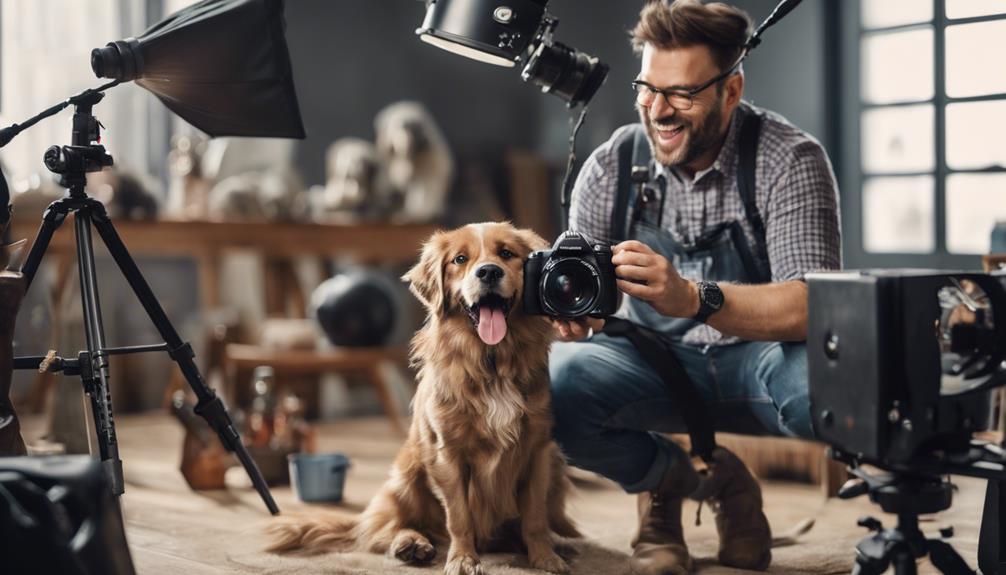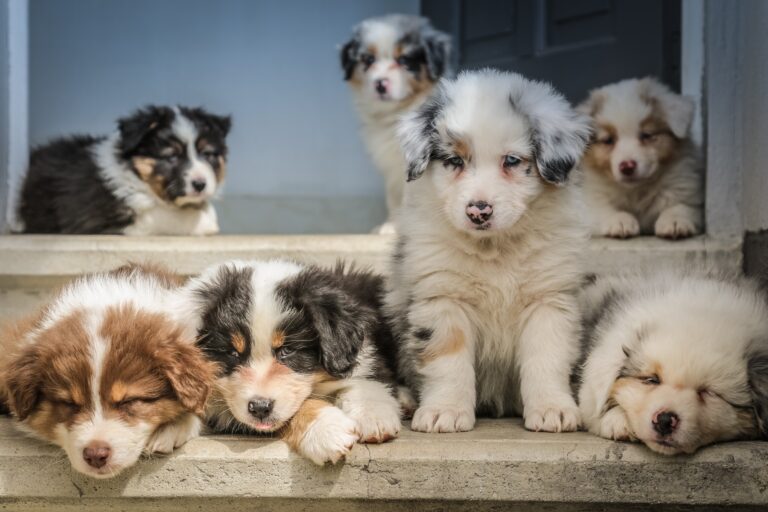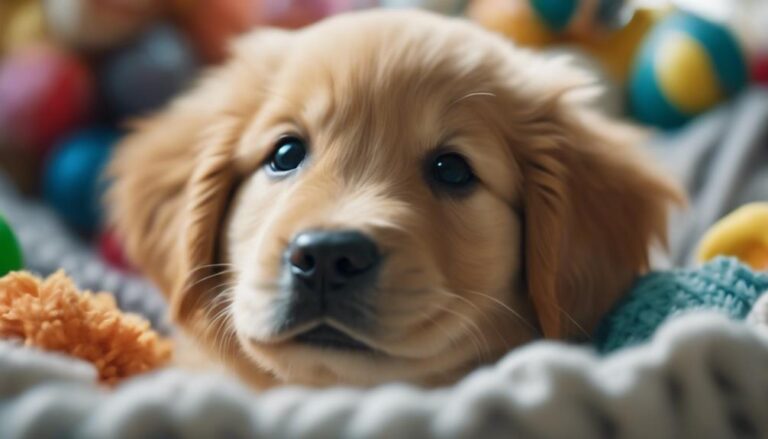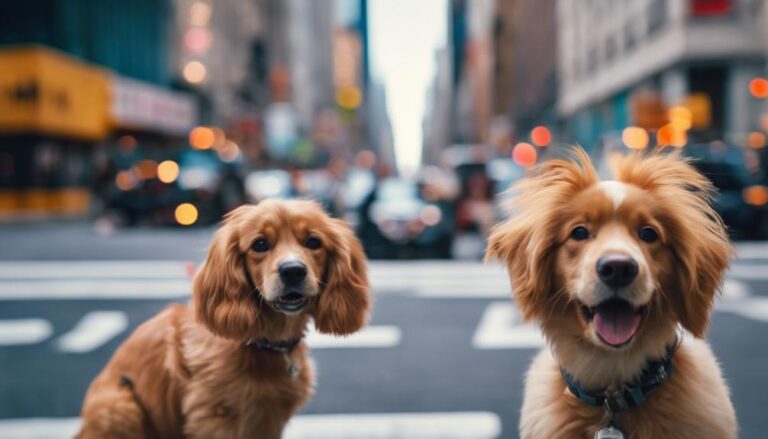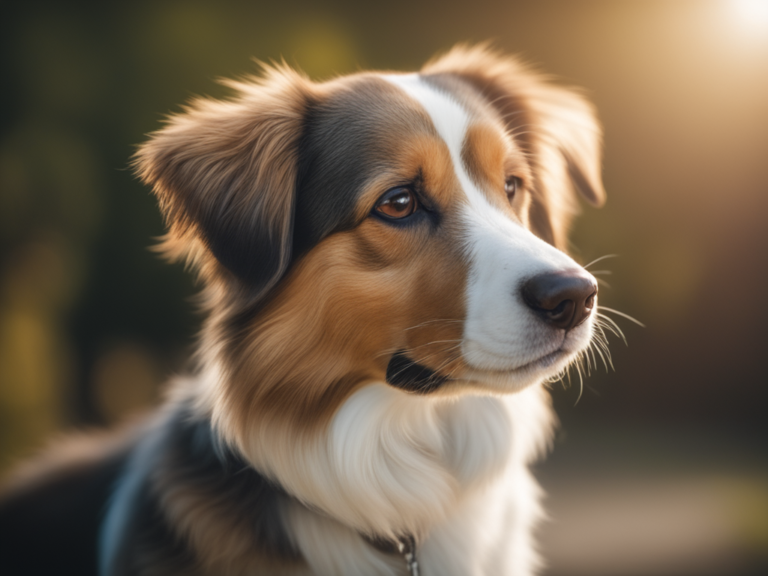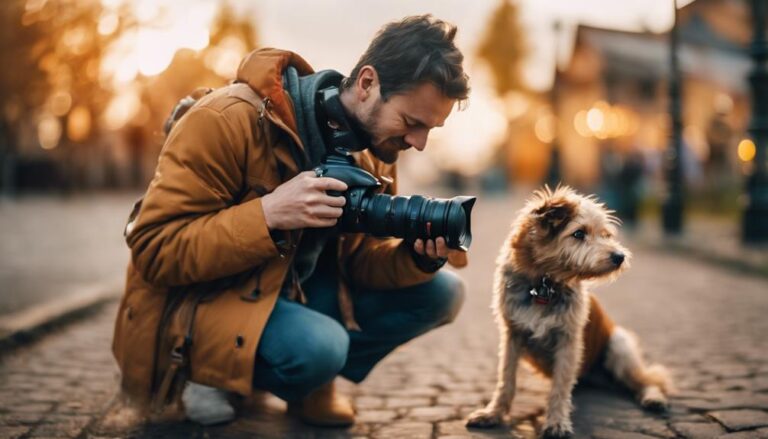In a pet photography career, enjoy flexible scheduling and build strong client relationships. Express your creativity capturing playful moments, but be prepared for unpredictable pet behavior. Develop patience and handle potential safety risks with care. Tackle market challenges by setting competitive prices and ensuring client loyalty. Manage income variability with multiple streams and financial planning. Embrace physical demands and self-promote your unique skills. Experience the joys and challenges of this field, balancing creativity with business strategy.
Flexibility in Scheduling
If you're considering a pet photography career, the importance in scheduling can be a major advantage. Time management plays a significant role in maintaining a healthy work-life balance when you have the freedom to set your own schedule. This flexibility allows you to prioritize personal commitments while still meeting the needs of your clients.
Being able to adjust your schedule according to your preferences can also help in building strong client relationships. Clients appreciate when you can accommodate their specific needs and availability, which can lead to repeat business and positive referrals. By offering flexible hours, you show that you value their time and are willing to work around their schedules to provide a convenient and personalized experience.
Maintaining a good work-life balance is essential for your overall well-being and productivity. With schedule flexibility, you have the autonomy to allocate time for both work and personal activities, reducing stress and preventing burnout. It allows you to pursue your passion for pet photography while still having time for family, friends, and hobbies.
Building Strong Relationships
When it comes to pet photography, establishing strong relationships with your clients is essential to fostering loyalty and generating referrals. Client communication plays a pivotal role in ensuring that you understand their expectations and preferences. Regularly updating clients on the progress of their pet photoshoots and promptly addressing any concerns they may have can go a long way in building trust and satisfaction.
Trust building is another critical aspect of developing strong relationships with your clients. Being transparent about your pricing, services, and the creative process helps in establishing trust and credibility. When clients feel confident in your abilities and trust your expertise, they are more likely to recommend your pet photography services to their friends and family.
Listening attentively to your clients' needs and providing personalized experiences can also contribute to strengthening your relationships. Taking the time to understand their pets' personalities and capturing unique moments that resonate with them showcases your dedication and commitment to delivering exceptional results. By going the extra mile to exceed your clients' expectations, you can solidify long-lasting relationships that benefit both your pet photography career and your clients' satisfaction.
Creative Expression Opportunity
When you embark on a pet photography career, you'll have the opportunity to release your creativity through your camera lens. You can experiment with different angles, lighting, and compositions to capture the distinctive personalities of the animals you photograph. This creative outlet allows you to showcase your artistic vision and connect with pet owners on a deeper level.
Artistic Freedom in Photography
Embrace the artistic freedom that comes with pet photography, allowing your creative vision to shine through each captured moment. Through artistic collaboration with pet owners or other artists, you can explore creative techniques that elevate your work. Visual storytelling is key in pet photography, where you have the opportunity to convey emotions and narratives through your images. Developing strong composition skills will enhance your ability to frame shots in a visually appealing way, drawing the viewer's eye to the subject. Experimenting with different angles, lighting, and post-processing techniques can help you create unique and impactful pet portraits. Artistic freedom in pet photography allows you to express yourself creatively while capturing the essence of your furry subjects.
Capturing Unique Pet Personalities
To capture the unique personalities of pets in your photography, focus on observing their behaviors and interactions with their environment. When taking pet portraits, pay attention to capturing emotions like joy, curiosity, or playfulness. Incorporate pet portrait tips such as using treats or toys to grab their attention and showcase their individuality. Stay updated on pet photography trends to explore creative concepts that can highlight the essence of each pet. Experiment with different angles, lighting, and compositions to bring out their distinctive traits. Remember that each pet has a story to tell, and it's your job to convey their personality through your lens. Embrace this opportunity to create meaningful and engaging pet portraits that resonate with pet owners.
Working With Playful Subjects
Engaging with lively pets during a photoshoot can be both thrilling and challenging for a pet photographer. Working with playful subjects often leads to dynamic and energetic sessions. When pets are in their playful element, capturing those candid playtime poses can result in some of the most memorable and endearing shots. These fun-filled sessions bring out the best in pets, showcasing their vibrant personalities in a natural and unscripted manner.
However, it's crucial to be prepared for the unpredictability that comes with working with playful pets. They may not always cooperate or sit still for the perfect shot, requiring patience and quick reflexes to capture those fleeting moments of joy and spontaneity. Building a rapport with the pets beforehand can help create a comfortable environment where they feel at ease to express themselves freely.
To make the most of working with playful subjects, consider incorporating toys or treats to keep them engaged and focused during the photoshoot. Interactive props can also add an extra element of fun to the session, encouraging pets to interact with their surroundings and allowing their playful nature to shine through in the photographs. Overall, while working with playful subjects can present its challenges, the resulting images often capture the true essence of a pet's character and spirit.
Potential Allergies and Safety Risks
When beginning your pet photography career, be mindful of potential allergies. Make sure you take necessary precautions to keep both yourself and the pets safe during the photoshoots. Safety should always be a top priority when working with animals.
Allergy Precautions for Pets
Taking care to address potential allergies and safety risks is vital when working with pets in the field of pet photography. Proper allergy management starts with understanding hypoallergenic breeds and the impact of pet dander. To reduce the risk of allergic reactions during photoshoots, make sure that pets are groomed and clean before the session. Regular grooming can help minimize shedding and dander, creating a safer environment for both the photographer and the pet. Additionally, it's important to inquire about any known allergies or sensitivities that the pet may have before the photoshoot. By taking these allergy precautions and being mindful of potential risks, you can create a comfortable and safe environment for capturing beautiful pet photos.
Ensuring Pet Photo Safety
To guarantee the safety of pets during photo sessions, it is critical to be mindful of potential allergies and safety risks. When handling pets for photography, ensure gentle and patient pet handling techniques to keep them calm and comfortable. Implement safety measures such as securing any potentially harmful props or equipment. Before the shoot, conduct thorough location scouting to identify any hazards that could endanger the pets. Consider lighting considerations to prevent any discomfort or distress caused by harsh lighting conditions. By paying attention to these details, you can create a safe and enjoyable environment for the pets during their photoshoot, ensuring both their well-being and the success of the session.
Handling Unpredictable Behavior
Prepare to adapt quickly to unexpected actions and reactions when handling unpredictable behavior during pet photography sessions. Behavior management plays an important role in ensuring successful photo shoots with pets. Implementing effective training techniques can help in managing unpredictable behavior and capturing stunning photographs.
When faced with a pet exhibiting unpredictable behavior, remain calm and patient. Utilize positive reinforcement techniques such as treats or toys to encourage desired behavior. By rewarding good behavior, you can create a positive association for the pet during the photography session. Additionally, understanding the pet's body language can help you anticipate any potential issues and adjust your approach accordingly.
Incorporating training techniques into your sessions can also aid in managing unpredictable behavior. Simple commands like 'sit' or 'stay' can help control the pet's movements and ensure they stay in place for the photos. Consistent training prior to the photo shoot can make a significant difference in how the pet responds during the session.
Remember that each pet is unique, and what works for one may not work for another. Be flexible and willing to try different strategies to handle unpredictable behavior effectively. By staying attentive and adaptable, you can navigate any challenges that arise during pet photography sessions and capture memorable moments with ease.
Competitive Market Challenges
Tackling the competitive market challenges in the pet photography industry requires strategic positioning and innovative approaches to stand out among your peers.
To navigate the competitive landscape effectively, consider the following key factors:
- Pricing Strategies: Implementing essential pricing strategies can help you attract clients while ensuring your services are valued in the market. Conduct thorough research on your competitors' pricing models to offer packages that are attractive yet sustainable for your business.
- Client Retention: Building strong relationships with your clients is vital for long-term success. Focus on providing exceptional customer service, personalized experiences, and quality work to foster loyalty among your clientele. Implementing client loyalty programs or referral incentives can also help in retaining customers.
- Marketing Tactics: In an important market, effective marketing is vital to reach your target audience and differentiate your services. Utilize social media platforms, collaborate with pet-related businesses or influencers, and showcase your work through a professional website or portfolio. By investing in strategic marketing tactics, you can increase your visibility and attract potential clients.
Emotional Attachment to Clients
Developing strong emotional connections with your clients is a fundamental aspect of building a successful pet photography business. Establishing trust and rapport through meaningful client relationships is key to fostering loyalty and repeat business. However, it is important to maintain a balance and set clear client boundaries to guarantee professionalism and avoid overstepping emotional boundaries.
Effective attachment management is essential in traversing the emotional landscape of working closely with pet owners. While forming genuine connections can enhance the overall experience for both you and your clients, it is important to remember the primary focus remains on providing quality photography services. By understanding the nuances of client relationships and being empathetic without becoming overly attached, you can cultivate a healthy dynamic that benefits everyone involved.
Setting boundaries with clients helps in managing expectations and maintaining a professional demeanor. It is essential to prioritize the photography aspect of your business while still acknowledging the emotional value that pets hold for their owners. By striking a balance between emotional engagement and professional conduct, you can create a rewarding experience for both yourself and your clients in the pet photography industry.
Variability in Income
Handling the financial aspect of your pet photography business can pose challenges due to the variability in income streams. This fluctuation in earnings can impact your overall stability and financial planning. To navigate this aspect successfully, consider the following:
- Income Stability: It's vital to establish multiple income streams within your pet photography business to create a more stable financial foundation. Diversifying your services, such as offering pet portraits, event photography, or even pet photography classes, can help offset fluctuations in income from one specific source.
- Client Communication: Maintaining open and effective communication with your clients is crucial for ensuring a steady flow of income. Clear communication about your services, pricing, and any additional fees can help prevent misunderstandings that may lead to payment delays or disputes. Building strong relationships with your clients can also result in repeat business and referrals, contributing to a more consistent income stream.
- Financial Planning: Developing a detailed financial plan that accounts for both your fixed costs and variable income can help you better manage the fluctuations in your pet photography business. Setting aside funds during high-earning periods to cover potential lean months can provide a buffer against income variability and help you maintain financial stability in the long run.
Physical Demands and Patience
Mastering the physical demands of pet photography requires patience and endurance to capture the perfect moments with animals. The job often involves long hours on your feet, crouching, kneeling, and moving swiftly to get the right angles. Physical endurance is essential as you may need to chase after energetic pets or carry heavy equipment to different locations. Patience is vital when working with animals who may not always cooperate, requiring you to adapt to their behavior and be flexible in your approach.
In pet photography, you must be adaptable to various environments and situations. Whether you're shooting in a client's home, a park, or a studio, you need to adjust quickly to different lighting conditions and backgrounds. Pets can be unpredictable, so being flexible in your methods is essential to capturing their unique personalities. Remember, animals have their own schedules and moods, so staying patient and calm will help you achieve the best results.
To excel in pet photography, you must be physically fit to handle the demands of the job and patient enough to wait for the perfect shot. Flexibility and adaptability are pivotal traits that will set you apart in this field. So, embrace the challenges with a positive attitude, and you'll be rewarded with stunning images that pet owners will cherish forever.
Marketing and Self-Promotion
Mastering the competitive world of pet photography requires strategic marketing and proactive self-promotion to showcase your unique skills and attract potential clients. Here are three essential strategies to boost your pet photography business:
- Social Media Presence and Networking: Utilize platforms like Instagram, Facebook, and Pinterest to share your work, engage with pet owners, and build a community around your brand. Networking with local pet-related businesses, such as groomers or pet stores, can also help you gain referrals and collaborations.
- Branding and Portfolio Development: Establish a strong brand identity that reflects your style and values as a pet photographer. Invest time in developing a cohesive portfolio that highlights your best work and showcases the range of services you offer. A well-curated portfolio not only attracts potential clients but also sets you apart from competitors.
- Client Testimonials and Reviews: Encourage satisfied clients to leave reviews and testimonials on your website or social media pages. Positive feedback from pet owners can greatly influence prospective clients when they are choosing a pet photographer. Word-of-mouth referrals are powerful in the pet industry, so prioritize building strong relationships with your clients.
Maintaining Equipment and Supplies
When maintaining your pet photography equipment and supplies, regular cleaning and inspection can help prolong their lifespan. Developing an organization system for your supplies can save you time and prevent any last-minute rushes. By taking care of your gear and keeping your supplies in order, you'll be better prepared for your pet photography sessions.
Equipment Maintenance Tips
To ensure the longevity and peak performance of your photography equipment, regular maintenance is essential. Here are three key equipment maintenance tips to keep your gear in top shape:
- Lens Cleaning: Use a soft brush or air blower to remove dust and debris before gently wiping the lens with a microfiber cloth and a small amount of lens cleaning solution.
- Proper Storage: Store your equipment in a cool, dry place away from direct sunlight and extreme temperatures to prevent damage and mold growth.
- Regular Inspections: Check your gear for any signs of wear and tear, loose parts, or malfunctions regularly to address any issues promptly and prevent further damage.
Supply Organization Strategies
Implementing efficient supply organization strategies is important for maintaining your photography equipment and supplies in excellent condition. To keep your gear in top shape, designate specific areas for different equipment categories such as cameras, lenses, lighting, and props. Use storage solutions like shelves, bins, and drawers to keep everything organized and easily accessible. Regularly clean and inspect your supplies to prevent damage and guarantee they are ready for use. Additionally, maintaining a well-organized digital workspace for photo editing can streamline your workflow and save time. Effective supply organization not only helps you stay on top of your equipment but also contributes to smoother client communication by allowing you to quickly locate and utilize the tools you need for each photoshoot.
Balancing Personal and Professional Life
Striking a balance between your personal life and professional commitments as a pet photographer is essential for long-term success and well-being. As you navigate the demands of running a pet photography business, consider the following tips to help you maintain equilibrium:
- Time Management: Efficiently managing your time is vital to prevent work from encroaching on your personal life. Create a schedule that allocates specific time slots for photography sessions, editing, client communication, and personal activities. Avoid overcommitting yourself and learn to prioritize tasks based on urgency and importance.
- Boundary Setting: Establish clear boundaries between your work and personal life to avoid burnout and maintain healthy relationships. Communicate your availability to clients, set realistic expectations regarding response times, and learn to disconnect during designated personal time. Setting boundaries also involves knowing when to say no to additional work or requests that may infringe on your personal time.
- Self-Care: Remember to prioritize self-care amidst your professional responsibilities. Take breaks when needed, engage in activities that rejuvenate you, and seek support from friends and family. Practicing self-care not only enhances your well-being but also improves the quality of your work as a pet photographer.
Frequently Asked Questions
How Can I Handle Difficult or Anxious Pets During a Photoshoot?
When dealing with difficult or anxious pets during a photoshoot, remember to stay calm and patient. Use calming techniques like gentle petting or offering treats to build trust. Handling aggression requires a firm but gentle approach.
Are There Specific Techniques or Tips for Capturing a Pet's Unique Personality in Photos?
To capture a pet's unique personality in photos, experiment with different lighting techniques and editing software. Focus on pet posing and background selection. Get down to their level, use natural light, and snap candid shots to bring out their individual charm.
What Are Some Common Misconceptions About Pet Photography as a Career?
Misconceptions about pet photography as a career can hinder your success. People often underestimate the challenges involved, assuming it's just playing with animals. But with the right skills, there are ample opportunities for growth and creativity.
How Do I Stay Updated on Industry Trends and Continue to Improve My Skills as a Pet Photographer?
Stay updated on industry trends and improve your skills as a pet photographer by taking online courses, workshops, and attending networking events, conferences. Engaging with these resources helps you stay current and grow professionally.
What Are Some Unexpected Challenges That May Arise When Working With Pets and Their Owners in a Photography Session?
When working with pets and their owners in a photography session, unexpected challenges like pet behavior management, client communication, time management, and location scouting can arise. Stay prepared by anticipating and addressing these issues proactively.
Conclusion
To sum up, pursuing a pet photography career can offer flexibility, creative expression, and the joy of working with playful subjects. However, it also comes with potential allergies, physical demands, and the need for marketing and self-promotion. Balancing your personal and professional life while maintaining equipment and supplies can be challenging. But if you have a passion for animals and photography, the pros may outweigh the cons in this rewarding career.

